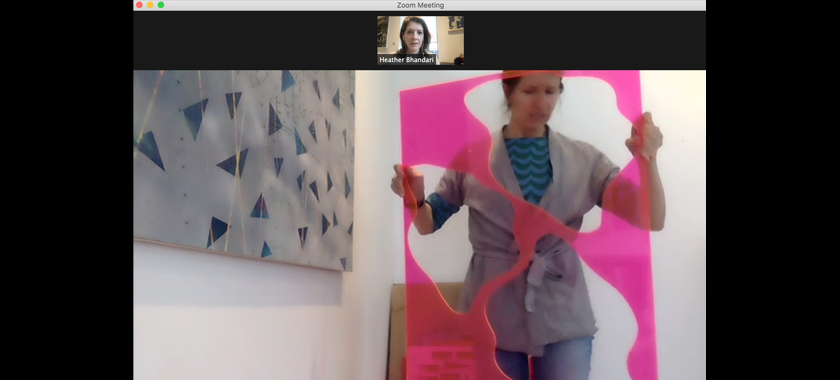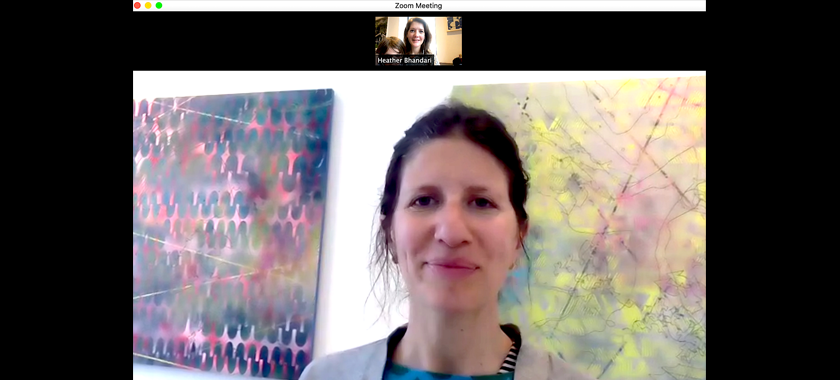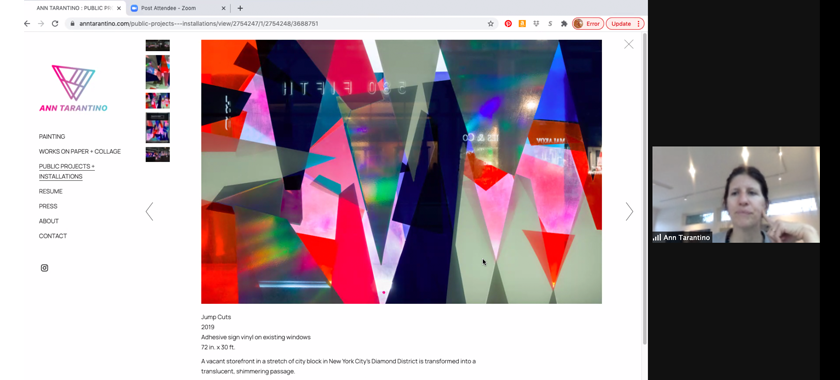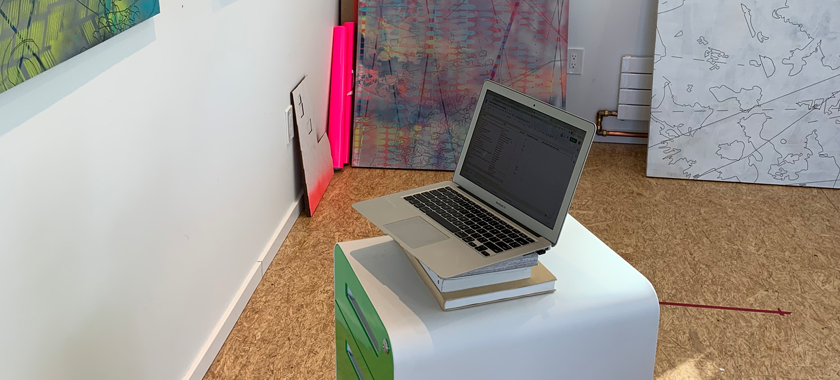
Business of Art | Online Studio Visits 101
How to prepare for and conduct online studio visits—courtesy of Heather Bhandari, co-founder of Art World Conference.
Heather Bhandari is an independent curator and co-founder of Art World Conference (Fiscally Sponsored by NYFA) who has a breadth of experience in the art world including serving as a director at Mixed Greens gallery in New York, NY and Director of Exhibitions at Smack Mellon gallery in Brooklyn, NY. Her career began at contemporary galleries Sonnabend and Lehmann Maupin, both in New York, NY. In this post, we’ll walk you through some of Bhandari’s tips for preparing for and making the most of online studio visits. “Nothing matters as much as the artwork that you make,” she advises. See below for more, which we have excerpted from her recent online workshop titled “Online Studio Visits: Preparation & Practice,” presented by NYFA Learning.
The Platform
Bhandari finds that online studio visits are primarily happening on Zoom, which offers a free basic service to individuals where you can host group meetings of up to 40 minutes and unlimited one-on-one meetings. “I’ve noticed that when I set up a meeting and I’ve set my controls, that it’s much easier to conduct the visit,” she says. When you set up a meeting, Bhandari suggests having a waiting room so that your guest can’t just pop in. Once set up, Bhandari advises sending a Google Calendar invite which sends all the Zoom information directly to them—and you’ll see when they say “yes” to the invite. She also encourages artists to send the Zoom invitation link to their guest in an email to confirm that they’re coming. Before the meeting, you can advance test functions like screen sharing to ensure that the viewing experience is a smooth one. If you’re sharing sound or video, check the “check-sound’ and “optimize for video clip” boxes. And because Zoom is updated regularly, make sure you’re using the most up-to-date version to avoid unnecessary tech issues.

The Tech Setup
Tech prep is key to a successful online studio visit. Bhandari advises that artists open any website tabs that they’ll be showing in advance and put a copy of their slideshow presentation on their desktop so it’s ready to go. If you have a second screen available, have your notes on your desktop and your slideshow on your other device. This helps you to be more present in the conversation, and less distracted by toggling back-and-forth between your materials. For those using tablets, this technology works differently than a typical computer. For example: when sharing from an app, Google Drive, etc., you will not be able to share your presentation and your live video. It is one or the other. Bhandari’s solution is to make your presentation a PDF, and put it in the cloud.
If you’re interested in walking around your studio, Bhandari’s hack is to log into the link with your computer and with your phone so that there are “two” of you in the meeting. Just make sure to turn the sound off on one of them and “flip” the view on your phone so you can see what your guest is seeing. If you are using a tablet or phone in any capacity during the visit, Bhandari recommends that you have a tripod in place where it is stationary as motion sickness is the number one problem with online studio visits. Another possible tech add is a selfie light, which is relatively inexpensive and can help if you have uneven light in your studio.

The Studio Setup
“The most important thing in a studio visit—whether it is in person or online—is editing,” says Bhandari. “With a studio visit online, you need the things that you want to show to be accessible,” she adds. Which means that you have to think through what you will show on screen (and what you choose to keep out of view) and how you want to frame your story. Questions to consider include: “What adds to my coherent story about my trajectory and who I am as an artist? Why am I making the work I’m making? What can I talk about the best?” There is no one way to approach your answers, as they differ for every artist.
Additionally, think about the visual story that you are telling. If your work hangs, Bhandari advises that you hang it. If it is a sculpture, “put it on something nice to make sure it looks professional, like it could be shown somewhere or bought.” For artists making works that are too big to show in an in-person or online studio visit, Bhandari encourages them to reflect the spirit of their work in the background. You could also set up a virtual background or greenscreen as a second option or consider bringing the person along on a site visit if your work lives elsewhere. Time of day factors in, as lighting can affect how your work is viewed and perceived.
There will be unconscious things that the people “visiting” your studio will pick up on, so try to envision your space from an outsider’s perspective to ensure that something incongruous won’t distract them from your message. “We’re trying to set up the idea that your work is valuable, that you as an artist are valuable, and your time is valuable,” says Bhandari.

The Practice
Don’t wing it! Do run-throughs to get comfortable with your set-up and process, and consider ways of trouble-shooting should things not go as planned. Anticipate that you will be expected to talk extensively about yourself and your work, but also allow space for listening and dialogue with your visitors. Bhandari suggests a presentation of about 10-15 minutes (if it’s a 45-minute studio visit) and that you think about “three things that you want someone to remember after the studio visit is over. If they remember nothing else, what is the Number One Thing that you think is super important about your work, your practice, and yourself as an artist? Then, think about what are two more and build your presentation and your studio visit around those ideas.” Bhandari advises that you write them down as notes next to your computer, but don’t create a script to avoid it feeling like a formal artist talk or lecture.
Make sure you’ve given yourself the time to build energy for the visit, because you want to make sure someone feels comfortable in your space. “Whether it’s a group or an individual, this is a human to human experience,” says Bhandari.
–Compiled by Amy Aronoff, Senior Communications Officer
You can find more articles on arts career topics by visiting the Business of Art section of NYFA’s website. Sign up for NYFA News and receive artist resources and upcoming events straight to your inbox.
NYFA Learning provides artists, creators, students, and arts administrators with tools, strategies, and advice for building sustainable careers. We collaborate with organizations, academic institutions, and cultural partners to bring our programs to a broad range of national and international creative communities.
NYFA Fiscal Sponsorship’s quarterly no-fee application deadlines are June 30, September 30, December 31, and March 31. We also accept Out-of-Cycle Review applications year-round. Reach out to us at [email protected] for more information.